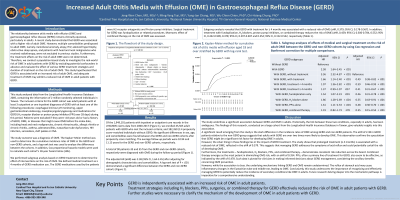Comprehensive Otolaryngology
(262) Increased Adult Otitis Media with Effusion in Gastroesophageal Reflux Disease
Monday, October 2, 2023
2:45 PM - 3:45 PM East Coast USA Time

Has Audio
.jpg)
Jeng-Wen Chen, MD, MSC
Deputy Superintendent
Cardinal Tien Hospital and Fu Jen Catholic University
New Taipei City, New Taipei, Taiwan (Republic of China)
Presenting Author(s)
Disclosure(s):
Jeng-Wen Chen, MD, MSC: No relevant relationships to disclose.
Introduction: The relationship between otitis media with effusion (OME) and gastroesophageal reflux disease (GERD) remains clinically equivocal, particularly in adults. Therefore, we conducted a population-based retrospective cohort study to investigate the risk of OME in adult patients with GERD and the effects of treatment.
Methods: This study analyzed data from the Longitudinal Health Insurance Database 2005, containing the information of 2 million randomly selected individuals in Taiwan. We enrolled 45,565 adult patients with newly diagnosed GERD between 2000 and 2017 and 182,260 matched individuals without GERD. The study outcome was a diagnosis of OME. The Kaplan–Meier method was used to determine the cumulative incidence rates of OME in the GERD and non-GERD cohorts, and a log-rank test was used to analyze the differences between the cohorts. In addition, Cox proportional hazards models were used to calculate each cohort's 18-year hazard ratios (HRs).
Results: A total of 90 patients—35 and 55 from the GERD and non-GERD cohorts, respectively—were diagnosed with OME during the follow-up period. The adjusted HR (aHR) was 2.38 (95%CI, 1.64-3.45) after adjusting for demographic characteristics and comorbidities. Subgroup analysis revealed that GERD with treatment for ≥ 4 months was associated with a reduced risk of OME (aHR, 0.379; 95%CI, 0.178-0.567). In addition, treatment with fundoplication, H2 blockers, proton pump inhibitors, or combined therapy reduces the risk of OME (aHR, 0.459; 95%CI, 0.306-0.784, 0.552; 95%CI, 0.432-0.909, 0.478; 95%CI, 0.297-0.697 and 0.354; 95% CI, 0.152-0.542, respectively).
Conclusions: GERD is independently associated with an increased risk of OME in adult patients. Treatment strategies for GERD effectively reduced the risk of OME in adult patients with GERD. Further studies were necessary to clarify the mechanism of the development of OME in adult patients with GERD.
